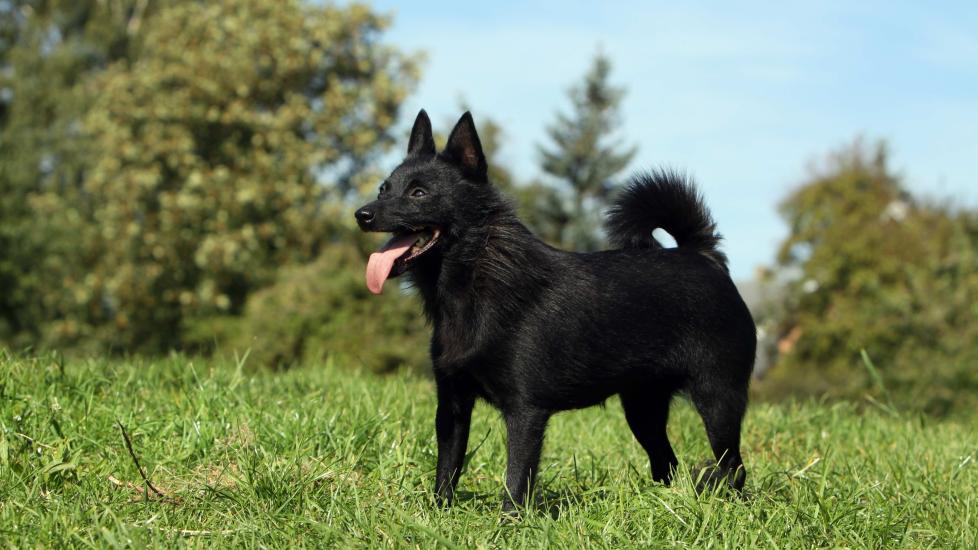Schipperke
The Schipperke is an affectionate little dog that originated in 1600s Belgium. They worked as watchdogs and rodent hunters on barges, which led to the name Schipperke, meaning “little captain” in Flemish. Schipperkes were first imported to the U.S. in 1888, according to the Schipperke Club of America (SCA), and the breed was officially recognized by the American Kennel Club (AKC) in 1904.
This small black dog breed weighs 10–16 pounds and stands 10–13 inches tall at the shoulder.
Caring for a Schipperke
Schipperkes are intelligent, curious dogs that have a lot of energy. They require activities that keep their mind engaged and their body active. Without this, they may bark to excess, engage in destructive chewing, or dig up your yard.
The Schipperke has a black, medium-length double coat. Weekly brushing helps keep the coat free of tangles and removes dead hair, but Schipperkes don’t need as much grooming upkeep as other fluffy dogs might.
Schipperke Health Issues
Schipperkes have a long lifespan of 12–16 years. While they’re generally a healthy breed, these dogs are predisposed to a few health conditions.
Patellar Luxation
The patella (kneecap) is a small bone that normally sits in a groove within the femur at the knee. In dogs with patellar luxation, the patella moves (or “luxates”) outside of its assigned groove when the knee is flexed. This inappropriate movement can cause discomfort and may lead to arthritis.
Treatment often involves anti-inflammatory medications, exercise restriction, and weight loss. Surgery may be necessary for severe cases.
Legg-Calvé-Perthes Disease
Legg-Calvé-Perthes disease is a condition in which the head of the femur breaks down, likely secondary to lack of blood supply. This bone deterioration causes pain and limping.
Legg-Calvé-Perthes occurs in young Schipperke dogs, typically in those less than 18 months old. In some cases, pain can be controlled with medications. In severe cases, surgery to remove the head of the femur may be recommended.
Progressive Retinal Atrophy
Progressive retinal atrophy (PRA) is a group of diseases that causes the breakdown of the photoreceptor cells (rods and cones) on the retina. Initially, your Schipperke may have difficulty seeing in the dark. But over time, the condition results in complete blindness.
PRA is often an inherited disease, so dogs with this condition should not be bred. There are currently no effective treatments.
Hypothyroidism
The thyroid gland controls the metabolism, and hypothyroidism causes the thyroid gland to be underactive. In Schipperkes with hypothyroidism, the body attacks its own thyroid gland.
Hypothyroidism is diagnosed using bloodwork, and it is treatable with levothyroxine, a thyroid hormone replacement medication. Though this is a lifelong medication, dogs with hypothyroidism can live long and happy lives.
Dental Disease
Dental disease is one of the most common conditions seen in dogs as they age, especially in small breeds like the Schipperke. Bacterial tartar and plaque lead to inflammation of the tissues around the teeth, and eventually to tooth and bone decay.
The best way to prevent dental disease is with daily tooth brushing with a dog-specific toothpaste. Never use human toothpaste on your pup—many contain xylitol, which is extremely toxic to dogs.
Routine dental cleanings are recommended to evaluate the mouth; remove plaque and tartar; polish teeth to prevent future buildup; and treat or extract significantly unhealthy teeth. X-rays of the teeth and surrounding bone are also recommended.
As with humans, dental disease can be a painful condition for a dog and may even affect the health of the internal organs.
What To Feed a Schipperke
Feeding an Association of American Feed Control Officials (AAFCO) kibble or wet food is a good way to make sure your Schipperke receives a complete and balanced diet.
Schipperke puppies should be fed a diet formulated specifically for puppies. In adults, diets focused on dental health may be recommended to help prevent dental disease.
How to Feed a Schipperke
Adult Schipperkes should be fed a measured amount twice a day. Puppies should be fed at least three meals a day to prevent low blood-sugar levels. You can offer your dog meals in a snuffle mat or slow feeder bowl for added mental stimulation.
How Much Should You Feed a Schipperke?
The perfect amount to feed your dog depends on your Schipperke’s size, metabolism, health, and lifestyle.
The best way to determine the feeding quantity is to talk with your veterinarian, who can calculate your dog’s caloric needs. The feeding guide labels on your dog food will also provide valuable information. Always measure your dog food out and avoid free-feeding, which can lead to obesity.
Nutritional Tips for Schipperkes
Schipperkes may benefit from added omega-3 fatty acids into their diets. Omega-3 fatty acids can be found in skin and joint supplements, fish oil, and some specially formulated dog foods. These fatty acids act as natural anti-inflammatories that help to support the skin, coat, kidneys, joints, and heart.
Behavior and Training Tips for Schipperkes
Schipperke Personality and Temperament
Despite the breed’s small stature, Schipperkes are active, confident dogs. The SCA describes the small black dog breed as being interested in everything around them, while maintaining a loyal but independent personality.
Schipperkes love their human family members and are often described as “Velcro dogs.” They are affectionate and patient with children who are gentle with pets.
Schipperke Behavior
The active and intelligent Schipperke needs lots of outlets for their energy. If bored and unstimulated, they may become an excessive barker, chewer, or digger. Take your Schipperke on frequent walks, and dedicate time for brain exercises like puzzles and games.
Due to their history as rodent hunters, some Schipperkes maintain a high prey drive and will chase small birds, rodents, reptiles, and (sometimes) cats. Proper socialization and introductions can help them learn that feline family members aren’t for chasing, but you should always keep your Schipperke on a leash or inside a fenced space when they’re outside. Otherwise, your little pup may dart off after a squirrel.
Schipperke Training
Like all dogs, Schipperkes should begin obedience training and socialization at an early age. They should be exposed to children, cats, and other dogs in a supervised setting early as well.
Despite their remarkable intelligence, Schipperkes are not always easy to train. They can be strong-willed and may get bored with standard training. Positive reinforcement and training games will help keep them interested.
Fun Activities for Schipperkes
-
Agility
-
Puzzles
-
Obedience training
-
Nose work
Schipperke Grooming Guide
The Schipperke has a black, medium-length double coat that’s longest on the neck and chest. This inky coat is fairly easy to care for; weekly brushing and routine bathing is all that’s needed for grooming.
Skin Care
Due to their protective double coat, the Schipperke usually has healthy skin and only needs a monthly bath, at most. Contact your vet if you notice changes in your dog’s skin.
Coat Care
Schipperkes go through a shedding
Eye Care
No special eye-related grooming care is necessary for Schipperkes, but contact your veterinarian if squinting or eye discharge is noted. These can be signs of more serious eye conditions.
Ear Care
Schipperkes do not have special ear care grooming needs. However, cleaning the ears every two weeks for maintenance may help prevent ear infections.
Considerations for Pet Parents
The Schipperke makes a remarkable pet for an active family that’s dedicated to keeping their dog well-exercised, stimulated, and socialized. But because of their history as rodent hunters, they may not do well in homes with smaller pets—even cats can be tricky without proper introductions and socialization.
Remember that Schipperkes are smart and need to be engaged. If they are left alone for long periods without anything to keep their brain busy, you’ll probably come home to shredded pillows or a dug-up flower bed.
As long as your Schipperke’s needs are met, they will be a happy pup that’ll curl up on the couch with you.
Schipperke FAQs
Are Schipperkes good family dogs?
The Schipperke is a wonderful pet for active families. While they require a lot of activity and mental challenges to stay out of trouble, they are affectionate little dogs that enjoy cuddling. Most do well with children and other dogs when socialized early.
How do you pronounce ‘Schipperke?'
In the United States, most people call this dog a “SKIP-er-kee.” In the original Flemish, however, Schipperke is pronounced "sheep-er-ker."
Do Schipperkes like to cuddle?
Despite their high activity needs, Schipperkes are cuddle bugs when in the home. They love to sleep in your lap after a long day of fun activities.
What colors are Schipperkes?
The only Schipperke color is black. If you see what looks like a white Schipperke, you’re probably looking at an American Eskimo Dog.
Featured Image: Adobe/Dogs

